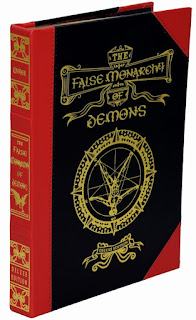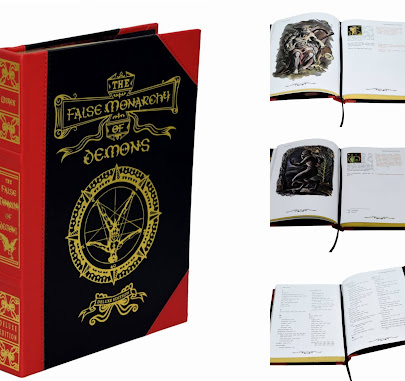THE FALSE MONARCHY OF DEMONS
Deluxe Edition
Written by Johann Weyer (or Johannes Wier), translated by Natalia Zasadzinska, edited by Michael Coles, with illustrations by Anna Dorzhieva, Asim Hussain, and Louis Le Breton.
Published by Abracax House.
Imitation Leather - Red with black edges and spine - in slip case, List Price: $54.99
Real Leather - Black with red edges and spine - in slip case, List Price: $79.99
FROM THE PUBLISHER:
Johann Weyer's Pseudomonarchia Daemonum is considered one of the great-granddaddies of demonic catalogues. Many later works, including Scot's Discoverie of Witchcraft and the Goetia, are considered derivatives of Weyer's classic. This Deluxe Edition of The False Monarchy of Demons was produced as a real leather-bound volume.
Our deluxe translation of Weyer's four hundred-year-old encyclopedic work of demonology includes digitally enhanced and enlarged versions of de Plancy's 19th century woodcuts from Dictionnaire Infernal, demonic seal reproductions, and newly-commissioned black and white and full-color illustrations, each providing a unique vision of these infernal beings.
The Deluxe Edition improves on previous editions with new artwork and larger type. The complete text has been re-edited and the layout updated for easier reading. The index is redesigned to make searching easy, and new full-color artwork is included. Each volume is bound in black and red real leather with gold foil embossing. The English text is shown in black, side-by-side with the original Latin text in red. This volume is delivered in a foil-stamped slipcase.
The Pseudomonarchia Daemonum was originally published as an appendix to the hugely popular De Prestigiis Daemonum. Since then, it has been used as the definitive reference and source for several grimoires including The Lesser Key of Solomon and the Infernal Dictionary. Natalia Zasadzinska is a professional translator and book author. Her previous works include translation of the first English translation of the full text of De Plancy's Infernal Dictionary.
**
QLIPHOTH - Opus IX:
The Arcanum Diaboli
Edited by Edgar Kerval
Published by Sirius Limited Esoterica,
Standard edition limited to 55 hand numbered copies. Hard cover with the art of Nigrae Edictium. Includes a ritual music cd called “Hyphernated Identities by Sean woodward
List Price: $55.00
FROM THE PUBLISHER:
The new opus of Qliphoth, consists of the other volumes, an anthology of sorcery and witchcraft including diverse essays and illustrations from diverse authors and artists worldwide. The elder arcanum and secret gnosis revealed through a volume full of enigmatic passages and mysterious revelations. Echoes of elder magickal transmissions, and sabbatic craft now revealed through 152 pages. Each opus reveals diverse methods of witchcraft and sorcery as a nexus for the awakening in man, through self-knowledge and experiences based on each opus.
The book includes interesting articles such as:
In the Hands of the Violent Divine: Magickal Acts of Devotional Violence,
by Shea Bilé
The Devil’s Due, by Kyle Fite
Mammon - The Hunger Within,
by Asenath Mason
Invoking the Enochian Elemental Forces of ‘The Tablet of Union’, by Aion 131
Thaumiel: Final Ravine of Universe and True Seeing, by Thomas Karlsson
Zothyrian Meta-Magick,
by Sean Woodward
Planetary Magick, an Introduction, by Bill Duvendack
The Art of Lucid Dreaming,
by Ricardo Meyer
The Metaphysical Mouth – An Introduction, by André Consciência
The Beginning and the End,
by Raven Stronghold
The Vessel of the spirits, by Edgar Kerval
**
LILITH, GENDER & DEMONOLOGY
By Stephanie Spoto
Published by Atramentous Press
Printed full colour cover, Head and Tail Bands & Book Ribbon. Limited to 333 copies.
Standard HardcoverEdition:
List Price: $114.95
FROM THE PUBLISHER:
Stephanie Spoto’s study of Lilith examines the feminine demonic. She succinctly demonstrates that the demonisation of the female is embedded in how we perceive and apprehend demonic icons such as Lilith. This is a study that goes back to the early modern period populated by such great ‘men’ as John Dee, Milton, and Shakespeare. For each applied and negotiated their understanding of threat by projecting their current fears onto and into aspects of such entities as Hecate and Lilith. While topics surrounding the destabilisation of societal equilibrium have always been present, Spoto shows that during the 16th and 17th century a projected impression of presences concerned with engaging with the demonic were being studied and practised. Fears over heresy, uncertainty, loss, treason, even sexual appetite threatened the continued aggrandisement of a patriarchal society, in accordance with this much was being done by magicians to usurp the feminine. It should therefore come as no surprise to learn that Stephanie Spoto successfully presents evidence which shows that rather than shunning Lilith, authors of the time were openly communicating and negotiating their sense of an existential reality and crisis via the demoness.
Lilith, Gender, and Demonology is a book for these times that we are currently living through. There is no denying the book has relevance for those interested in gender studies and the ongoing dialogue over maintaining strict dichotomous renderings of identity. And even though the study is quite obviously embedded by its historical context, the themes, along with the notion of metaphysical relations reveal the kernel to our contemporary occult studies. From the inclusion of the reappropriated Goddess found among various witchcraft movements, to the demonology that continues to be practised by occultists, the topic of Lilith continues to be a salient one. Beyond Hebraic studies, there is little that is truly known about Lilith other that what has been conjectured. Lilith, Gender, and Demonology corrects this shortfall in part by simply being a devastatingly good read, however, it is more than this, Spoto shares the knowledge uncovered by having accessed collections rarely seen by most. Consequently, Lilith, Gender, and Demonology is a highly informative work which has a definite application for practitioners and would be practitioners when it comes to dynamics and the comprehending of the experiential. This has left me in no doubt that Spoto’s work is destined to become one of the most important books to have been published on Lilith.





Comments